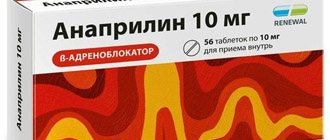Pharmacological properties of the drug Propranolol
Propranolol is a lipophilic non-selective β-adrenergic receptor blocker without BCA. Reduces the frequency and strength of heart contractions, slows down AV conduction, and reduces the myocardium's need for oxygen. It has a membrane-stabilizing effect and reduces the incidence of ectopic foci. The therapeutic effect consists of a negative chronotropic and inotropic effect on the myocardium. The hypotensive effect stabilizes by the end of 2 weeks of treatment. Propranolol is resorbed from the digestive tract by more than 90% and during the initial passage through the liver is metabolized by almost 70%. Bioavailability - about 30%. With long-term use, propranolol is almost completely metabolized, and up to 18 different metabolites can be identified. 4-Hydroxypropranolol has weak β-adrenolytic activity. The volume of distribution of propranolol is 3.61 l/kg, binding to plasma proteins is 93%. The maximum concentration in blood plasma is achieved 1–2 hours after administration. Elimination of propranolol occurs primarily through the liver and more than 90% in the form of metabolites. The half-life is 3–6 hours.
Pharmacodynamics and pharmacokinetics
The medication has antiarrhythmic, antianginal, and hypotensive effects. The principle of action is based on the indiscriminate blocking of beta-adrenergic receptors, on reducing the formation of cAMP from ATP, stimulated by catecholamines , which leads to a decrease in the flow of calcium ions into the cell, negative dromo-, chrono-, bathmo-, inotropic effects are formed (myocardial contractility is reduced, excitability is inhibited and conductivity, the pulse slows down).
At the first stages of treatment on the first day, OPSS may increase as a result of the elimination of the stimulating effect of beta-2-adrenergic receptors of blood vessels in skeletal muscles, as well as as a result of a reciprocal increase in the activity of alpha-adrenergic receptors . After 1-3 days, the effect returns to the original one, and with long-term therapy it decreases. The hypotensive effect is provided by sympathetic stimulation of peripherally located vessels, a decrease in blood flow, an effect on the central nervous system, a decrease in the sensitivity of baroreceptors in the aortic arch (there is no increase in activity in response to a drop in blood pressure), a decrease in the activity of the renin-angiotensin system (especially important for patients with initial hypersecretion of renin). Stabilization of the hypotensive effect is achieved by the end of the second week of course therapy.
The antianginal effect is achieved by reducing the need for myocardial (due to negative inotropic and chronotropic effects). A decrease in heart rate improves myocardial perfusion and causes prolongation of diastole . Due to an increase in end -diastolic pressure in the left ventricle and increased stretching of the ventricular muscle tissue, an increase in oxygen demand is possible, especially this effect is recorded in patients with chronic heart failure. The antiarrhythmic effect is achieved by eliminating arrhythmogenic factors (arterial hypertension, increased cAMP content, increased activity of the sympathetic nervous system, tachycardia ), slowing down atrioventricular conduction , and reducing the rate of spontaneous excitation of ectopic and sinus pacemakers. Inhibition of impulse conduction is recorded to a greater extent in the anterograde and to a lesser extent in the retrograde direction along additional pathways and through the atrioventricular node.
In the classification of antiarrhythmic drugs, Propranolol belongs to group 2 drugs. Reducing the severity of myocardial ischemia is ensured by reducing the myocardial oxygen demand. Thanks to the antiarrhythmic effect, a decrease in post-infarction mortality is achieved. The drug is able to prevent the development of headaches of vascular origin due to a decrease in the severity of cerebral vascular dilation as a result of beta-blockade of receptors in the vessels, a decrease in platelet adhesiveness, inhibition of lipolysis and aggregation (under the influence of catecholamines), a decrease in renin secretion, increased stimulation of oxygen supply to tissues, preventing the activation of blood clotting factors during the release of adrenaline.
The use of the drug Propranolol leads to a decrease in the severity of tremor due to the blockade of peripherally located beta-2 adrenergic receptors. The drug can increase the atherogenic properties of blood. The medication in large dosages causes a sedative effect , increases bronchial tone, and increases contraction of the uterine walls caused by the action of drugs that stimulate the myometrium.
Side effects of the drug Propranolol
Increased fatigue, dizziness, headache, paresthesia and feeling of coldness in the extremities, dyspepsia, bronchospasm, skin reactions, conjunctivitis, increasing signs of heart failure, bradycardia, AV conduction disorders, arterial hypotension, sleep disturbances, depression, nightmares, hallucinations, increased peripheral circulation disorders, decreased lacrimation, hypoglycemia, a feeling of dry mouth, muscle cramps and weakness, potency disorders, in some cases - blurred vision and keratoconjunctivitis, increased angina attacks.
Contraindications
Propranolol is not prescribed for SA blockade, cardiogenic shock , pregnancy, cardiomegaly, Prinzmetal's angina, sinus bradycardia, sick sinus syndrome, decompensated CHF, acute heart failure, intolerance to the main component, COPD, arterial hypotension, bronchial asthma, psoriasis , myasthenia gravis, liver failure, breastfeeding, diabetes mellitus with ketoacidosis, occlusive pathology of peripheral vessels (complicated by pain at rest, gangrene or intermittent claudication ), while taking monoamine oxidase inhibitors, metabolic acidosis .
For depression, Raynaud's syndrome , kidney pathology, allergies, thyrotoxicosis, children and the elderly, Propranolol is prescribed with caution.
Special instructions for the use of the drug Propranolol
Patients with pheochromocytoma should be given concurrent α-adrenergic blockers. Propranolol should be used with caution in cases of AV conduction disorders, in patients with diabetes mellitus and during fasting. In case of impaired liver and kidney function, it is necessary to reduce the dose of propranolol. Propranolol can affect the body's psychophysical abilities, weakening attention and slowing down responses, especially when consuming alcohol or taking drugs that depress the central nervous system. Propranolol penetrates the placental barrier. No studies have been conducted on the use of propranolol in the first trimester of pregnancy. In order to prevent bradycardia, arterial hypotension, hypoglycemia, respiratory depression (neonatal asphyxia) in a newborn, it is necessary to interrupt propranolol therapy 48–72 hours before the expected date of birth. The newborn should be left under medical supervision for 48–72 hours.
Indications for use
Instructions for use of Propranolol recommend prescribing the medication for angina pectoris , arterial hypertension, sinus tachycardia, unstable angina, atrial fibrillation, tachycardia , myocardial infarction, alcohol withdrawal (tremor, agitation), ventricular extrasystole , atrial fibrillation, essential tremor , ventricular extrasystole, thyrotoxic crisis (an auxiliary element of complex therapy), diffuse toxic goiter , with sympathoadrenal crises (concomitant diencephalic syndrome), with diffuse toxic goiter, pheochromocytoma , anxiety.
Drug interactions Propranolol
During IV therapy with calcium antagonists (verapamil and diltiazem), the use of β-adrenergic receptor blockers is contraindicated (except for intensive therapy). With the simultaneous administration of propranolol and norepinephrine or MAO inhibitors, a sharp increase in blood pressure is possible. When propranolol is combined with tricyclic antidepressants, barbiturates, anesthetics, antihypertensive and vasodilator drugs and diuretics, a sharp decrease in blood pressure is observed. The cardiodepressive effect of propranolol is potentiated by its combination with antiarrhythmic or anesthetic drugs. The negative chronotropic and dromotropic effect of propranolol is manifested when it is taken in combination with reserpine, clonidine, methyldopa, guanfacine and cardiac glycosides. Propranolol enhances the effects of tubocurarine. When taking propranolol and insulin or oral hypoglycemic drugs, the symptoms of hypoglycemia are masked, especially during physical activity. Cimetidine increases the content of propranolol in the blood plasma.
Propranolol analogs
Level 4 ATC code matches:
Sotalol Canon
Obzidan
SotaHEXAL
Sotalex
Anaprilin
Analogues and synonyms are medicines: Obzidan , Propranolol Hydrochloride , Opranol , Anaprilin , Tenomal , Inderal .
Overdose of the drug Propranolol, symptoms and treatment
Symptoms of propranolol intoxication depend on the patient's initial condition. In severe heart failure, even low doses of propranolol can cause signs of overdose; symptoms of damage to the digestive tract, cardiovascular system and central nervous system predominate. Possible feelings of fatigue, loss of consciousness, mydriasis, sometimes convulsions, arterial hypotension, bradycardia up to asystole, bronchospasm, hypoglycemia, shock. To eliminate the symptoms of overdose, intravenous administration of 1–2 mg of atropine is indicated, as well as the use of drugs with β-sympathomimetic activity (dopamine, dobutamine, isoprenaline, orciprenaline, epinephrine). Glucagon should first be administered intravenously at a dose of 0.2 mg/kg, then increase the dose to 0.5 mg/kg over 12 hours.
List of pharmacies where you can buy Propranolol:
- Moscow
- Saint Petersburg
Propranolol tablets, instructions for use (Method and dosage)
Heart rhythm disturbances, angina pectoris: 20 mg three times a day; gradually increase the dose to 120 mg (2-3 doses). The maximum daily dosage is 240 mg.
Arterial hypertension: twice a day, 40 mg. In case of ineffectiveness or weak effect, the amount of Propranolol is increased to 80 mg (2 times a day) or up to 40 mg (3 times a day). The maximum daily dosage of the drug is 320 mg (in severe, exceptional cases - 640 mg).
Essential tremor, migraine : initial amount – 40 mg 2-3 times a day, later the dosage is increased to 160 mg per day. Long-acting forms of the drug (80 mg depot capsules) are taken once a day.
Thyrotoxic crisis, paroxysmal cardiac arrhythmias: intravenous, slow, jet infusion in an initial dosage of 1 mg (1 ml of 0.1% solution), repeat the procedure after 2 minutes. If ineffective, the amount of medication administered intravenously is increased to 10 mg under mandatory monitoring of ECG and blood pressure levels.
Stimulation of labor, obstetrics: 20 mg of propranolol 4-6 times at intervals of 30 minutes (daily amount 80-120 mg). In case of fetal hypoxia, the dosage is reduced. In case of pathology of the renal system, no dose adjustment is required. For liver diseases, it is necessary to reduce the amount of the drug. To prevent postpartum complications, the medication is prescribed at a dose of 20 mg 3 times a day. Course 3-5 days.
Reviews of Propranolol
According to reviews, Propranolol effectively copes with all indications for the use of this medication. However, it is important to follow the instructions for use and dosages.
Reviews about the treatment of hemangioma with Propranolol
In 2008, French doctors identified the positive effect of this active drug on the fight against hemangioma. Also, you can already find examples of positive results of such treatment. However, one should remember about contraindications for the use of the drug, and also that today the drug is not protocol for the treatment of hemangioma, since the effect of this medication has not yet been sufficiently studied. In any case, you should definitely consult your doctor on this topic.




